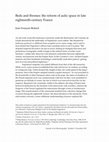Papers by Jean-François Bédard

The Journal of Art Historiography, Dec 1, 2013
An advocate of pre-Revolutionary monarchy under the Restoration, the Countess de Genlis denounced... more An advocate of pre-Revolutionary monarchy under the Restoration, the Countess de Genlis denounced the artificiality of Napoleonic court culture. She shunned its ludicrous protocol, so different from accepted ancien régime usage, and is said to have hinted that Napoleon's officers had consulted actors to set it in place. 1 She despised imperial decorative art just as much, finding its inelegant heaviness and pretentious iconography totally foreign to the refined forms of earlier royal furniture-unlike later observers who detected continuities between eighteenthcentury neoclassicism and the Empire Style. In the Countess's view, strident Empire interiors and their bombastic furnishings could hardly mask their patrons' glaring lack of social and political legitimacy. 2 Napoleonic etiquette was indeed different from that of the old monarchy. While ancien régime protocol established the rank and favour of courtiers according to a temporal scale, which dictated the length of time one could spend in the king's presence, that of the Empire adopted instead a spatial measure. 3 As was practised in the households of other European rulers such as the pope, the status of members of the French imperial court was commensurate with how far they were permitted to penetrate an enfilade of rooms, the last of which was reserved exclusively for the emperor. Required to be constantly visible to his subjects, the king of France had bestowed distinction by the duration of his intercourse with courtiers, whereas the Emperor of the French regulated his interactions through a form of architectural triage. This transformation of the ceremonial resulted from a decisive change that occurred during the eighteenth century: the desacralization of the monarchy. From mid-century onward, a more utilitarian understanding of power replaced the This article is based on a paper presented at the international conference 'Le néoclassicisme dans les colonies européennes XVIII e-XIX e siècles', organized by the Musée des arts décoratifs de l'Océan Indien in La Réunion. I thank Jean-Philippe Garric for his helpful suggestions.
McGill-Queen's University Press eBooks, Dec 15, 1994
JSTOR is a not-for-profit service that helps scholars, researchers, and students discover, use, a... more JSTOR is a not-for-profit service that helps scholars, researchers, and students discover, use, and build upon a wide range of content in a trusted digital archive. We use information technology and tools to increase productivity and facilitate new forms of scholarship. For more information about JSTOR, please contact
JSTOR is a not-for-profit service that helps scholars, researchers, and students discover, use, a... more JSTOR is a not-for-profit service that helps scholars, researchers, and students discover, use, and build upon a wide range of content in a trusted digital archive. We use information technology and tools to increase productivity and facilitate new forms of scholarship. For more information about JSTOR, please contact

Journal of the Society of Architectural Historians, Sep 1, 2011
Bertrand Jestaz . Jules Hardouin-Mansart . Paris:: Editions A. et J. Picard: 2008, 2 vols., 399, ... more Bertrand Jestaz . Jules Hardouin-Mansart . Paris:: Editions A. et J. Picard: 2008, 2 vols., 399, 255 pp., 54 color and 328 b/w illus. €79, ISBN 9782708408173 Alexandre Gady editor. Jules Hardouin-Mansart, 1646–1708 . Paris:: Editions de la Maison des sciences de l'homme: 2010, 612 pp., 400 color and 94 b/w illus. €96, ISBN 9782735111879 Alexandre Gady . Bâtir pour le roi: Jules Hardouin-Mansart (1646–1708) . Paris:: Musee Carnavalet—Histoire de Paris: 2009, 33 pp., some color illus., plans. €2, ISBN 978275961042 Jules Hardouin-Mansart (1646–1708) was the son of an obscure painter, Raphael Hardouin. As a youth, he first trained with his great uncle, the famous Francois Mansart, whose prestigious family name he added to his own after the elder architect died in 1666. In 1673 he became involved with the Bâtiments du roi (the king's works), when its superintendent, Jean-Baptiste Colbert, selected him for an inspection mission to the Languedoc. Hardouin-Mansart's career was launched, and it progressed rapidly thereafter. A member of the Royal Academy of Architecture in 1675, he became First Architect of the King in 1681 and, unexpectedly for a building professional, Surintendant des Bâtiments in 1699. Only once before had this prestigious position, traditionally earmarked for the nobility, been held by an architect, Philibert Delorme. As superintendent and first architect, Hardouin-Mansart took on simultaneously the roles of client and architect—a convenient, if ethically problematic, convergence. This concentration of power helped him reorganize the Bâtiments. Prefiguring the modern architectural office, he set up a hierarchical structure from the apex of which he oversaw numerous draftsmen and building managers. This efficient configuration enabled him to satisfy both Louis XIV's voracious appetite for building and the copious demands placed on the Bâtiments, which included not only public buildings in the provinces but also private requests from members of the court. As his career advanced, Hardouin-Mansart also rose through the ranks of society: he was ennobled in 1682; the king bestowed on him the title of Chevalier de l'Ordre de Saint-Michel in 1693; and in 1699 he took his place among the landed gentry as the Comte de Sagonne. To an extent, Hardouin-Mansart's professional and social success had a negative effect on the critical reception of his work. The Duc de Saint-Simon, ever on guard to preserve the privileges of the old …
In November 1894 an album of drawings of the Louvre was auctioned in Paris. Contained within the ... more In November 1894 an album of drawings of the Louvre was auctioned in Paris. Contained within the album is an anonymous and undated plan of the ground floor of the Cour Carrée. This article argues that the survey for this plan was sponsored by educator and architect Jacques-François Blondel, and give evidence for this attribution
This article discusses the ways in which Gabriel Huquier altered the designs of other artists and... more This article discusses the ways in which Gabriel Huquier altered the designs of other artists and printmakers to create new prints. In particular, Bédard examines Huquier\u27s reproduction of a copy of Cesare Ripa\u27s Iconologia. Huquier did not appropriate Oppenord\u27s Ripa in its entirety or follow the original sequence of drawings. Instead he produced a series of prints that feature elements randomly chosen from it. Bédard argues that Oppenord and Huquier were both bricoleurs, but who had different objectives for their projects. While Oppenord attempted to interpret the text, Huquier was concerned with profit
Philippe II, duc d\u27Orléans and his architect, Gilles-Marie Oppenord, embraced the grand goût s... more Philippe II, duc d\u27Orléans and his architect, Gilles-Marie Oppenord, embraced the grand goût style and recast the Palais-Royal as a surrogate Versailles. This shift imagined the Palais-Royal as the center for royal power during the Regency period. This article traces the ways in which renovations from 1713 until 1723 transformed the Palais-Royal. While Louis XV moved the seat of power back to Versailles, Paris remained the center for French politics thanks to duc Orléans and Oppenord
Journal of the Society of Architectural Historians, 2009
JSTOR is a not-for-profit service that helps scholars, researchers, and students discover, use, a... more JSTOR is a not-for-profit service that helps scholars, researchers, and students discover, use, and build upon a wide range of content in a trusted digital archive. We use information technology and tools to increase productivity and facilitate new forms of scholarship. For more information about JSTOR, please contact










Uploads
Papers by Jean-François Bédard